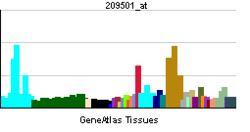CDR2 (gene)
| CDR2 | ||||||
|---|---|---|---|---|---|---|
| Identifiers | ||||||
| Aliases | CDR2, CDR62, Yo, cerebellar degeneration related protein 2 | |||||
| External IDs | MGI: 1100885 HomoloGene: 7262 GeneCards: CDR2 | |||||
| RNA expression pattern | ||||||
 | ||||||
| More reference expression data | ||||||
| Orthologs | ||||||
| Species | Human | Mouse | ||||
| Entrez | ||||||
| Ensembl | ||||||
| UniProt | ||||||
| RefSeq (mRNA) | ||||||
| RefSeq (protein) | ||||||
| Location (UCSC) | Chr 16: 22.35 – 22.44 Mb | Chr 7: 120.96 – 120.98 Mb | ||||
| PubMed search | [1] | [2] | ||||
| Wikidata | ||||||
| View/Edit Human | View/Edit Mouse |
Cerebellar degeneration-related protein 2 is a protein that in humans is encoded by the CDR2 gene.[3][4]
See also
References
- ↑ "Human PubMed Reference:".
- ↑ "Mouse PubMed Reference:".
- ↑ Fathallah-Shaykh H, Wolf S, Wong E, Posner JB, Furneaux HM (May 1991). "Cloning of a leucine-zipper protein recognized by the sera of patients with antibody-associated paraneoplastic cerebellar degeneration". Proc Natl Acad Sci U S A. 88 (8): 3451–4. doi:10.1073/pnas.88.8.3451. PMC 51465
 . PMID 2014264.
. PMID 2014264. - ↑ "Entrez Gene: CDR2 cerebellar degeneration-related protein 2, 62kDa".
Further reading
- Gress T, Baldini A, Rocchi M, et al. (1992). "In situ mapping of the gene coding for a leucine zipper DNA binding protein (CDR62) to 16p12-16p13.1.". Genomics. 13 (4): 1340–2. doi:10.1016/0888-7543(92)90063-X. PMID 1505970.
- Sakai K, Mitchell DJ, Tsukamoto T, Steinman L (1992). "Isolation of a complementary DNA clone encoding an autoantigen recognized by an anti-neuronal cell antibody from a patient with paraneoplastic cerebellar degeneration.". Ann. Neurol. 30 (5): 738. doi:10.1002/ana.410300523. PMID 1763903.
- Sakai K, Mitchell DJ, Tsukamoto T, Steinman L (1991). "Isolation of a complementary DNA clone encoding an autoantigen recognized by an anti-neuronal cell antibody from a patient with paraneoplastic cerebellar degeneration.". Ann. Neurol. 28 (5): 692–8. doi:10.1002/ana.410280515. PMID 2260856.
- Bonaldo MF, Lennon G, Soares MB (1997). "Normalization and subtraction: two approaches to facilitate gene discovery.". Genome Res. 6 (9): 791–806. doi:10.1101/gr.6.9.791. PMID 8889548.
- Fletcher CF, Okano HJ, Gilbert DJ, et al. (1998). "Mouse chromosomal locations of nine genes encoding homologs of human paraneoplastic neurologic disorder antigens.". Genomics. 45 (2): 313–9. doi:10.1006/geno.1997.4925. PMID 9344654.
- Takanaga H, Mukai H, Shibata H, et al. (1998). "PKN interacts with a paraneoplastic cerebellar degeneration-associated antigen, which is a potential transcription factor.". Exp. Cell Res. 241 (2): 363–72. doi:10.1006/excr.1998.4060. PMID 9637778.
- Okano HJ, Park WY, Corradi JP, Darnell RB (1999). "The cytoplasmic Purkinje onconeural antigen cdr2 down-regulates c-Myc function: implications for neuronal and tumor cell survival.". Genes Dev. 13 (16): 2087–97. doi:10.1101/gad.13.16.2087. PMC 316965
 . PMID 10465786.
. PMID 10465786. - Sakai K, Shirakawa T, Li Y, et al. (2002). "Interaction of a paraneoplastic cerebellar degeneration-associated neuronal protein with the nuclear helix-loop-helix leucine zipper protein MRG X.". Mol. Cell. Neurosci. 19 (4): 477–84. doi:10.1006/mcne.2001.1059. PMID 11988016.
- Strausberg RL, Feingold EA, Grouse LH, et al. (2003). "Generation and initial analysis of more than 15,000 full-length human and mouse cDNA sequences.". Proc. Natl. Acad. Sci. U.S.A. 99 (26): 16899–903. doi:10.1073/pnas.242603899. PMC 139241
 . PMID 12477932.
. PMID 12477932. - Sutton IJ, Steele J, Savage CO, et al. (2004). "An interferon-gamma ELISPOT and immunohistochemical investigation of cytotoxic T lymphocyte-mediated tumour immunity in patients with paraneoplastic cerebellar degeneration and anti-Yo antibodies.". J. Neuroimmunol. 150 (1-2): 98–106. doi:10.1016/j.jneuroim.2003.12.026. PMID 15081253.
- Gerhard DS, Wagner L, Feingold EA, et al. (2004). "The status, quality, and expansion of the NIH full-length cDNA project: the Mammalian Gene Collection (MGC).". Genome Res. 14 (10B): 2121–7. doi:10.1101/gr.2596504. PMC 528928
 . PMID 15489334.
. PMID 15489334. - Balbo M, Barel M, Lottin-Divoux S, et al. (2005). "Infection of human B lymphoma cells by Mycoplasma fermentans induces interaction of its elongation factor with the intracytoplasmic domain of Epstein-Barr virus receptor (gp140, EBV/C3dR, CR2, CD21).". FEMS Microbiol. Lett. 249 (2): 359–66. doi:10.1016/j.femsle.2005.06.052. PMID 16054780.
External links
- CDR2 human gene location in the UCSC Genome Browser.
- CDR2 human gene details in the UCSC Genome Browser.
This article is issued from Wikipedia - version of the 6/6/2016. The text is available under the Creative Commons Attribution/Share Alike but additional terms may apply for the media files.